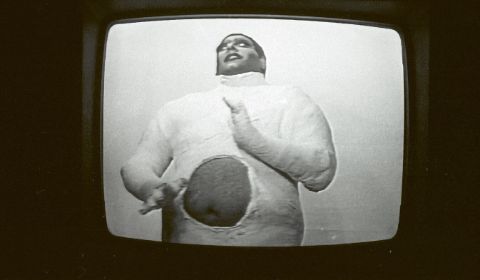Carlos Leppe

Carlos Leppe, still from Las Cantatrices (1980). Courtesy of Archivo Carlos Leppe
With the harsh reality of life under dictatorship, Carlos Leppe demonstrates, by means of his own flesh, the implications for the individual and collective body of those regimes that control and limit all aspects of sociality. A seminal figure in Chile for an art that uses and addresses the body and the porosity of its psychological processes, Leppe’s happenings, actions, installations, and objectual and pictorial production are full of symbolism. His works reveal and hide the body’s textual readability, inviting the viewer to deal with discomfort and confusion, while witnessing both sides of what a body is capable of enduring and resisting. Here, participation is a moral invitation to make visible and denounce institutionalized violence. It is also a modus that the artist engages to produce his work, clearly exemplified in the crediting of his collaborators who recorded his performances on camera, for example cultural theorist Nelly Richard, who directed the four videos in the exhibition. In three of them, Leppe’s body is fully encased in medical plaster, striking poses that parody theatrical tragedy, keeping openings to the breasts, to what resembles a pregnant belly, and an inverted triangle that conceals the genitals. Against the backdrop of the colours of the Chilean flag, he, in full operatic make-up, mouths the mad scenes of arias sung by Maria Callas, while dental forceps pull open his lips. The flamboyance and expressivity of Leppe is contrasted and amplified by disfiguring torture and the emotionally intense sounds of three monitors screaming at the same time. All of this, while his mother reads in the fourth video a report of the agonizing physical experience of the artist’s birth. The suffering body present in Leppe’s work became an x-ray image of a society that underwent extreme homogenization, regulation, and oppression.
WORK IN THE EXHIBITION: Las Cantatrices (1980), 4-channel video performance (BETA), colour, sound, 18'20''. Courtesy of Archivo Carlos Leppe